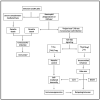From Infection to Death: An Overview of the Pathogenesis of Visceral Leishmaniasis
- PMID: 37513817
- PMCID: PMC10384967
- DOI: 10.3390/pathogens12070969
From Infection to Death: An Overview of the Pathogenesis of Visceral Leishmaniasis
Abstract
Kala-azar, also known as visceral leishmaniasis (VL), is a disease caused by Leishmania infantum and L. donovani. Patients experience symptoms such as fever, weight loss, paleness, and enlarged liver and spleen. The disease also affects immunosuppressed individuals and has an overall mortality rate of up to 10%. This overview explores the literature on the pathogenesis of preclinical and clinical stages, including studies in vitro and in animal models, as well as complications and death. Asymptomatic infection can result in long-lasting immunity. VL develops in a minority of infected individuals when parasites overcome host defenses and multiply in tissues such as the spleen, liver, and bone marrow. Hepatosplenomegaly occurs due to hyperplasia, resulting from parasite proliferation. A systemic inflammation mediated by cytokines develops, triggering acute phase reactants from the liver. These cytokines can reach the brain, causing fever, cachexia and vomiting. Similar to sepsis, disseminated intravascular coagulation (DIC) occurs due to tissue factor overexpression. Anemia, hypergammaglobulinemia, and edema result from the acute phase response. A regulatory response and lymphocyte depletion increase the risk of bacterial superinfections, which, combined with DIC, are thought to cause death. Our understanding of VL's pathogenesis is limited, and further research is needed to elucidate the preclinical events and clinical manifestations in humans.
Keywords: Leishmania donovani; Leishmania infantum; clinical presentation; innate immunity; kala-azar; pathogenesis; systemic inflammation; visceral leishmaniasis.
Conflict of interest statement
The authors declare no conflict of interest.
Figures



References
-
- Kassebaum N.J., Arora M., Barber R.M., Bhutta Z.A., Brown J., Carter A., Casey D.C., Charlson F.J., Coates M.M., Coggeshall M., et al. Global, regional, and national disability-adjusted life-years (DALYs) for 315 diseases and injuries and healthy life expectancy (HALE), 1990–2015: A systematic analysis for the Global Burden of Disease Study 2015. Lancet. 2016;388:1603–1658. doi: 10.1016/S0140-6736(16)31460-X. - DOI - PMC - PubMed
-
- Wamai R.G., Kahn J., McGloin J., Ziaggi G. Visceral leishmaniasis: A global overview. J. Glob. Health Sci. 2020;2:e3. doi: 10.35500/jghs.2020.2.e3. - DOI
-
- Kumar V., Mandal R., Das S., Kesari S., Dinesh D.S., Pandey K., Das V.R., Topno R.K., Sharma M.P., Dasgupta R.K., et al. Kala-azar elimination in a highly-endemic district of Bihar, India: A success story. PLoS Negl. Trop. Dis. 2020;14:e0008254. doi: 10.1371/journal.pntd.0008254. - DOI - PMC - PubMed
Publication types
Grants and funding
LinkOut - more resources
Full Text Sources

